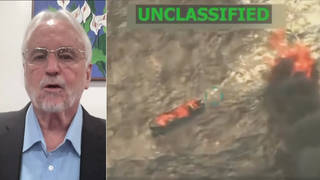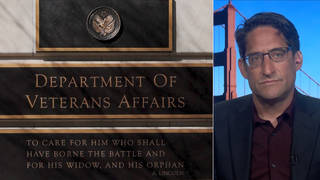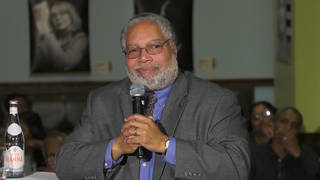
Topics
Guests
- Major Barry Venablepublic affairs officer at United States Space Command.
- Karl Grossmaninvestigative reporter, College of Westbury, author of the forthcoming book, Weapons in Space, and TV documentary, Star Wars Returns.
- Debora MacKenzieEuropean correspondent for New Scientist magazine.
- Bruce Gagnoncoordinator, Global Network Against Weapons and Nuclear Power in Space.
When President George W. Bush chose Donald Rumsfeld as his secretary of defense, he gave a clear signal that the United States would push forward with plans for a national missile defense system. Rumsfeld headed a congressional commission charged with assessing the ballistic missile threat facing the U.S. His report warned that within five years a rogue state, such as North Korea or Iran, could obtain a ballistic missile capable of reaching the U.S.
The conservative Republican senator from Arizona, Jon Kyl, whose motto is “peace through strength, not peace through paper,” praised Rumsfeld’s report as the main reason the debate was gradually turned around and the administration turned around.
But in the report of the United States Space Command, Vision for 2020, missile defense is only one step in the Space Command’s plans to control space in the next 20 years.
Transcript
AMY GOODMAN: You’re listening to Pacifica Radio’s Democracy Now! I’m Amy Goodman. When President George W. Bush chose Donald Rumsfeld as his secretary of defense, he gave a clear signal that the United States would push forward with plans for a national missile defense system. Rumsfeld headed a congressional commission charged with assessing the ballistic missile threat facing the United States. His report warned that a, quote, “rogue state,” such as North Korea or Iran, could obtain a ballistic missile capable of reaching the U.S. within five years. But in the report of the United States Space Command, titled “Vision for 2020,” missile defense is located as only one step in the Space Command’s plans to control and dominate space in the next 20 years.
Today, we’ll take a look not only at the U.S. plans for a national missile defense system, but also at the U.S. Space Command and its plans for the militarization of space. We begin with Major Barry Venable, the public affairs officer at the United States Space Command.
The report, “Vision for 2020,” begins with the following. It says, “Historically, military forces have evolved to protect national interests and investments — both military and economic. During the rise of sea commerce, nations built navies to protect and enhance their commercial interests. During the westward expansion of the continental United States, military outposts and the cavalry emerged to protect our wagon trains, settlements, and railroads. …
“The emergence of space power follows both of these models. Over the past several decades, space power has primarily supported land, sea, and air operations — strategically and operationally. During the early portion of the 21st century, space power will also evolve into a separate and equal medium of warfare. Likewise, space forces will emerge to protect military and commercial national interests and investment in the space medium due to their increasing importance.”
What is meant by “space power will also evolve into a separate and equal medium of warfare,” Major Barry Venable?
MAJ. BARRY VENABLE: Well, I think we need to start off with the understanding that, as far as the U.S. military is concerned, space is a center of gravity or a key cornerstone of our ability to perform our missions. I would also submit that it’s a — space is a center of gravity for the United States as a whole. We use space every day in ways that other countries are only beginning to adopt. Take for example, every time you use a credit card, that transaction at some point moves through space.
AMY GOODMAN: What are the plans for development of space weapons?
MAJ. BARRY VENABLE: Well, currently, and this is key to understand, the notion of weapons in space is not consistent with U.S. national policy. Planning for the possibility that someday they may be is the purpose of the U.S. Space Command long-range plan. Important to understand that should our civilian leadership at some point decide that application of force from space is in our national interest, we feel that it is our responsibility to have at least planned for that eventuality or possibility.
AMY GOODMAN: When money is in the budget for, say, NASA, that is separate from the Pentagon. And yet, would you say that these two areas are merging now and that there are perhaps — when there’s budget for NASA, these are hidden costs for the Pentagon?
MAJ. BARRY VENABLE: No, I would not say that. I’m not qualified to comment on the NASA budget. Civil space operations are separate and distinct from military operations from a budgetary responsibility standpoint. It’s important to understand, though, that due to the extremely high cost associated with space systems, that the civil, commercial and military sectors are rapidly seeking to capitalize on each other’s capabilities. In the military, for example, we make extensive use of imaging satellites, commercial imaging satellites, and the products derived from them, rather than undertaking the [inaudible] launching our own programs.
AMY GOODMAN: Let me ask you something. In the Vision for 2020, it says, under “future trends,” “Although unlikely to be challenged by a global peer competitor, the United States will continue to be challenged regionally. The globalization of the world economy will also continue, with a widening between 'haves' and 'have-nots.'” What does that mean? Why is the U.S. Space Command concerned about this?
MAJ. BARRY VENABLE: Well, we’re concerned that, from a space standpoint, when we say “haves” and “have-nots,” there are going to be those who have space assets and those who do not. Those who do not, however, can very easily, through asymmetric means, attempt to deny us use of our space assets.
AMY GOODMAN: The United States has been part of the Outer Space Treaty, an international treaty initiated by the U.S. to keep weapons out of space for 34 years. What’s your position on that treaty?
MAJ. BARRY VENABLE: Well, the Outer Space Treaty, adopted in 1967, among other items, essentially promotes the idea that space should be used for peaceful purposes. It specifically refers to the moon and other celestial bodies. One of the key provisions of the Outer Space Treaty is that nuclear weapons and other weapons of mass destruction cannot be placed into orbit or stationed in space in any manner. And quite simply, that is the key element of that treaty as it relates to our topic today. The important thing to understand, that I think is, in fact, national policy, is that unless something’s specifically prohibited, it’s permitted. And the Outer Space Treaty quite simply bans weapons of mass destruction in space, but it doesn’t ban weapons in space.
AMY GOODMAN: And so, the weapons that are acceptable?
MAJ. BARRY VENABLE: Well, weapons are only acceptable provided that our national civilian leadership decides so.
AMY GOODMAN: In November of 2000, the U.N., concerned about U.S. plans for a national defense system, voted to reaffirm the Outer Space Treaty. The U.S. and Israel were the only two countries to abstain. Why did the U.S. abstain?
MAJ. BARRY VENABLE: No, I can’t speak for the government of the United States in that regard.
AMY GOODMAN: Finally, the U.S. Space Command’s long-range plan thanks 75 corporations for their contributions, like Lockheed Martin, Boeing. How are corporations involved with the U.S. Space Command’s plan, plans overall? Is it appropriate that corporations, which are profit-seeking by nature, should be involved?
MAJ. BARRY VENABLE: Well, I think the question as it relates to the space industry can be applied to any other industry which supports any facet of the military, whether that is producing food or producing rocket boosters. We rely very heavily on the private space sector for launch capability and leverage some of their capabilities in space. The expertise found there, in what is really a very narrow career field, a very specialized career field, whether it be in the commercial, civil or military sector, is very valuable. And so we seek those — their input, solicit their assistance, in what is a very challenging endeavor, whenever one attempts to operate in space.
AMY GOODMAN: Well, Major Barry Venable, I want to thank you for being with us, public affairs officer at the U.S. Space Command.
MAJ. BARRY VENABLE: You’re very welcome. Thank you.
AMY GOODMAN: Thank you. And you are listening to Pacifica Radio’s Democracy Now!, as we continue on our conversation with weapons in space. I’m sorry that Major Venable would not go on with people, with critics of national missile defense and weapons in space. But we are joined on the phone by Karl Grossman, investigative reporter at the College of Old Westbury and author of the forthcoming book, Weapons in Space. He also did the TV documentary Star Wars Returns. Your response to some of what Major Barry Venable had to say about the use of weapons in space and whether the development of weapons violates the Outer Space Treaty, which the United States is a signatory on, Karl Grossman?
KARL GROSSMAN: Well, the intent of the U.S. military, particularly the U.S. Space Command, is — it’s declared in numerous documents. For example, I have one in front of me here called the United States Space Command Vision for 2020. And it opens up declaring U.S. Space Command “dominating the space dimension of military operations to protect US interests and investment.” Goes on to describe the model: “During the rise of sea commerce, nations built navies to protect and enhance their commercial interests. During the westward expansion of the continental United States, military outposts and the cavalry emerged to protect our wagon trains, settlements, and railroads.” Goes on about the “globalization of the world economy” continuing, with a widening gap between the “haves” and the “have-nots.” Put it all together, clearly what the U.S. Space Command thinks its role is, it’s kind of like the great fleets of the empires of Europe or the cavalry. We would attempt to, from space, the ultimate high ground of space — that’s the way space is described in military documents — control the planet below.
As to the Outer Space Treaty, it was in fact initiated by the United States in the early '60s to keep war out of space. I've spoken indeed, for the new TV documentary Star Wars Returns, he appears, Craig Eisendrath, explaining that our focus — he was in the State Department at the time — our focus was to keep weapons out of space, period. Eisendrath said, “Well, in the end, it came to say there’s a prohibition against nuclear weapons, of weapons of mass destruction.” He believes that the laser weapons that the U.S. Space Command, U.S. military wants to put up in space are also a violation of the Outer Space Treaty and, certainly, the intent of the Outer Space Treaty. And then, finally, Canada, just to clear up any confusion, has been moving at the United Nations to strengthen the Outer Space Treaty and have it say “no weapons in space, period.” But the U.S. has been challenging, has been fighting that.
AMY GOODMAN: I wanted to bring Debora MacKenzie into this discussion, a European reporter for New Scientist magazine. She’s in Brussels right now. What effect does the development of national missile defense and space weapons have on Europe, where you are, and China? Will it have the stabilizing effect the U.S. predicts?
DEBORA MacKENZIE: No, it will have a very destabilizing effect. Every single ally of the United States is opposed to this, just about. The Europeans are terribly opposed to it, I think possibly because they’re used to living in a world where you rub up against other countries a bit more often than possibly most Americans do. For one thing, they’re very much aware of what national missile defense in the United States is going to do to China. China is basically going to literally go ballistic.
AMY GOODMAN: What do you mean?
DEBORA MacKENZIE: Well, right now China has a fleet of sort of basic but usable ballistic missiles, nuclear-tipped, a single nuclear warhead per missile. Those typically, if Star Wars ever works, are what it’s going to be easiest to shoot down. Nuclear missiles that have more than one warhead on them are considered to be more likely to get around such a system. But single-weapons missiles are considered to be sitting ducks, if indeed NMD ever works. So China is going to feel in a position where the United States could, if it chose, bomb it, and it can’t bomb back. And it’s not going to like that, and it’s not going to allow that situation to persist. So what it will do, first of all, is it’s going to develop a new generation of nuclear warheads, missiles with more than one warhead on them. That means it’s going to have to test. That means it’s never going to ratify the Comprehensive Test Ban Treaty. And that’s just for starters.
Right now China is blocking progress on the treaty that could end the nuclear arms race. It’s been on the agenda in Geneva for a couple of years, but it’s gone nowhere. It’s called the Fissile Material Cutoff Treaty, and it’s a treaty that will effectively ban its participants from producing highly enriched uranium or plutonium, or at least any more of it, for use in nuclear weapons. It will basically, at one fell stroke, you know, end the arms race, because you won’t be able to produce any more fuel. Well, that would be great, but China has prevented any discussion of it, subject to the Americans stopping any support for national missile defense.
AMY GOODMAN: Have European nations muted their criticism at all since George W. Bush was selected as president here?
DEBORA MacKENZIE: Not really. Certainly not, no. I think top-placed officials, I think, if memory serves, the prime minister in France and Germany, have come out, since it was clearly going to be George W. Bush in the White House, and reiterated their long-standing opposition to national missile defense. Britain’s in a rather more ambiguous position. I think the Brits would, as usual, like to play honest broker between the Europeans and the Americans. And rumor has it that there are some in the inner circles in Tony Blair’s Cabinet that are not entirely opposed to the idea of national missile defense, possibly because they feel they could possibly creep in under the edge of it. But that’s simply rumor. Certainly, officially, they are very dubious about it. So far, they’ve been sort of trying to communicate between the two camps. But there doesn’t seem to be a lot of communication on this. The Europeans have said repeatedly that they don’t like this.
AMY GOODMAN: I wanted to wrap up the discussion with Bruce Gagnon, who’s coordinator for Global Network Against Weapons and Nuclear Power in Space. What are you doing at the grassroots level around the issue of weapons in space?
BRUCE GAGNON: Well, since 1992, we’ve been building an international constituency to educate and mobilize people around the world to keep space for peace, to make sure that this new arms race doesn’t move into the heavens. Particularly what we do is I spend about two to three weeks out of the month traveling around the United States and around the world, first to key communities where the Space Command has installations and where the aerospace corporations are working on Star Wars technology, to teach people about all the things we’ve learned from reading the Space Command documents, Vision for 2020 and other things like that. And now we’re going out beyond that, just to other communities, and really building this whole infrastructure.
And then, in coming months — excuse me — we have a whole series of protests. Starting February 3rd, there’s going to be a protest in Munich, when Rumsfeld goes there to try to convince the European allies to come on board Star Wars. And then, February 10th through 12th, we’re going to be in Albuquerque, New Mexico, protesting at a major space nuclear power and propulsion conference, because they’re talking about using nuclear power in order to generate the massive power projection capabilities for these space-based laser weapons that they’d like to begin flight testing by the year 2012. And then, in March, we’re having a national space organizing conference and protest in Huntsville, Alabama, Huntsville at the Army — Red Stone Arsenal is one of the places where missile defense is being directed. And then, in May, we’re having an international conference in Leeds, England, a place where the United States has one of the radar facilities — actually, two of them in that area — but that need to be updated for Star Wars, and so the British government has to give their permission.
AMY GOODMAN: That does it for today’s program. Democracy Now! is produced by Terry Allen and Kris Abrams; our engineer, Anthony Sloan; Errol Maitland, our technical director. From the embattled studios of WBAI, from the studios of the banned and the fired, from the studios of our listeners, I’m Amy Goodman. Thanks for listening to another edition of Pacifica Radio’s Democracy Now!











Media Options